

The Mixson Coat of Arms
By Larry Mixson
The following describes the John Leslie’s endeavor to obtain an Official Coat of Arms from the College of Arms, London England. It is based on original correspondence with the College of Arms and documents saved by John Leslie Mixson over the course of 1958 to 1972
Note: Superscript numbers in brackets are reference numbers assigned to the referenced document from John Leslie Mixson’s research folders, e.g. [f20-c01] A completed list of folders and documents can be found in the list of documents.
The Mixson Coat of Arms
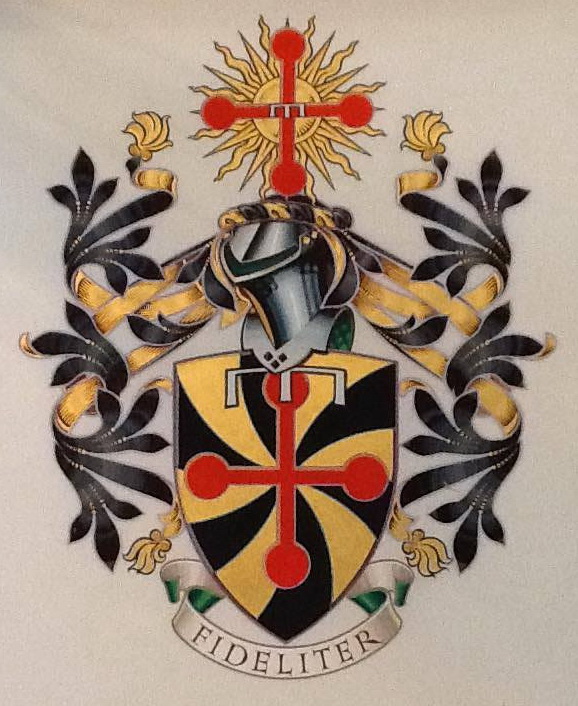
Description
Gyromy embowed of twelve – Or and Sable – a Cross pommy Gules And
for the Crest On a Wreath of Colours In front of a Sun Or a Cross
Pommy Gules
Motto: FIDELITER
From the official coat of arms granted by the College of Arms,
London, 1969
In modern English
A shield divided into twelve sections of yellow and black with a red
cross on the shield with globes at the ends.
A crest of a red cross
with globes at the ends in front of a yellow sun.
The motto “Fideliter” is Latin for faithful, loyal, devoted.
See Coat of Arms Glossary for a list of terms.
---------------------
I’m not sure when John Leslie Mixson started his genealogy research but the earliest letters in his files show him requesting records from various archives in 1957. From the early years of research, he determined that a John Mixon was the headright that came to America around 1650 from England and in 1959 inquired about a Mixson coat-of-arms.
From his Mixon-Mixson family Volume III
In 1959 I bought a Coat of Arms from a firm in York, England, which had run an ad in an American magazine. I had first written the firm to see if they had one for the Mixson family. Some days later I was advised that their own records did not list the name, but after checking with the British Museum they were advised that the following description of Arms belonged to the Mixson family.
"Or, a chevron gules between three trefoils vert. Crest - A trefoil vert. ”
Since the price was modest, I sent them my check and after some weeks I received the plaque with the Coat of Arms emblazoned on it.
Some few years later a MIXON friend of mine living in an adjoining state advised me he had a similar experience, had ordered from the same firm and received a Coat of Arms with same description. (This one for MIXON).
Many families through the years have displayed a Coat Of Arms, presumably without tracing their lineage back to the original holder of the Arms and verifying their right to display same.
I could not do this for my own line, therefore, I took the matter up with the College of Arms in London. They advised me that if I could prove descent from an ancestor who lived in this country during or prior to the Revolution who had emigrated from England, I could receive a grant of Arms. This I did, and a grant was made to me and my descendants in 1969. I was very grateful.
The point above was made in a newspaper clipping that John had saved in his archives.[f20-d12]
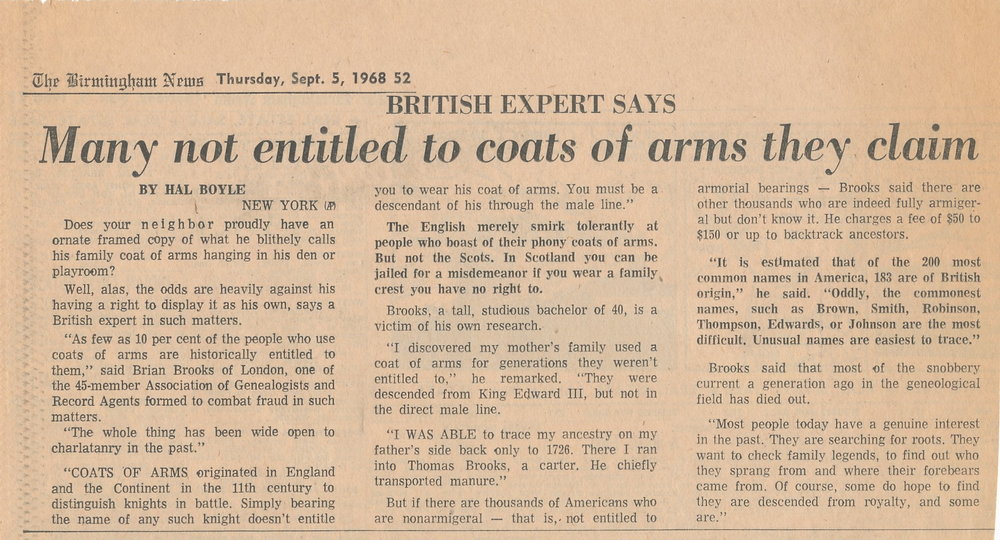
The following is the story of John obtaining an official coat-of-arms for the Mixson family name.
In early 1958 John contacted[f20-c01] Mrs. Allison M. Severe in Baltimore, Maryland who was a Commercial Artist who also did research and then made prints of coat-of-arms. Mrs. Severe trying to find the “official” coat-of-arms contacted the College of Arms in London about the design of the Mixson coat-of-arms asking them to “prove out” if the following was description of a Mixson coat-of-arms.
Arms: Or, a chevron between three leopard's faces, gules.
Crest: An arm embowered in armour, the hand grasping a sword, all proper
She the closest thing she was able to find was the following for the family “Maxton” and wondered if it might be a variant of “Mixson”.
Arms: Or, a chevron gules between three crosses formee fitchee sable.
Crest: An arm in armour, embowered, the hand grasping a broken spear, all proper
An interesting note is the reference to “cheveron between three leopard’s faces” which we find in some of the images of “unofficial” coat of arms like the example below. (“Or” is the color yellow, see glossary for coat-of-arms terminology.)
Two unofficial Mixon Coat of Arms Found on the Internet
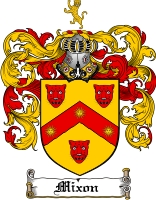

In April Mrs. Severe received a reply from A. R. Wagner, Richmond Herald at the College of Arms, London. Wagner informs Mrs. Severe that he is the new Librarian and Registrar of the College of Arms in London and that he would research a Mixon-Mixson coat of arms for the sum of £10. [f20-c02] Apparently, no further action was taken by Mrs. Severe.
In August of 1959 John himself wrote to A. R. Wagner at the College of Arms, London saying he received John’s letter in which Wagner stated in a British wishy-washy way about the cost of the research, “The sum I originally quoted was not a definite fee but a sum on account, likely but not certain to cover a substantial amount of the cost”, but he would put the search in his secretary’s hands. [f20-c03]
It appears that John did not pursue the research at the time for the next letter John received from A. R. Wagner was in September of 1963. [f20-c04] Wagner, at this time, had moved up from Librarian to the position of Garter King of Arms at the College of Arms in London. Wagner informs John that the material John had sent him was not sufficient for the needed research but “One hundred pounds worth of searching by us here should enable me, if not to solve the problem, then at any rate to form a clear picture of its nature”. Wagner then suggest that John by his “little book” English Ancestry for the amount of one dollar. It wasn’t until March of 1965 that John sent the money and Wagner sends the book.[f20-c05]
It was not until three years later March 1968 that John contacts Wagner, the Garter King of Arms, again to pursue the matter. Wagner writes[f20-c06]
“The first step would be to prove and record here your male line of descent from a British subject. This would not necessarily mean going back to England, for an ancestor who was a British subject in the American colonies before 1863 is just as good for this purpose.”
Wagner says the fee for the Patent of Arms is £157.10. On the back of the letter John computes the cost in dollars using longhand arithmetic (after all he is a banker), $378.00. By 1968 John had mostly completed his book the Mixon-Mixson family tracing his linage back to John Mixon the 1st who came from England in 1650 so John sends Wagner the “evidence” which was likely pages from his forthcoming book and Wagner replies[f20-c07]
“There is clearly, here a basis for expectation that we should be able to prove the necessary pedigree and put you in a position to apply for a Patent of Arms.”
Wagner then goes on to ask for John to send £200 and he “will arrange to have this put in hand.” John sends Wagner the money and Wagner replies stating the money was received[f20-c09]
After reviewing the material, in July, the Wagner sends a letter to John with a list of “particulars” for which he wants John to send more information. [f20-c10] In August of ’68, Thomas Woodward, a genealogist for Wagner sends John a letter requesting more details and an “attestation form” so that the request can placed before the Examiners.[f20-c13]
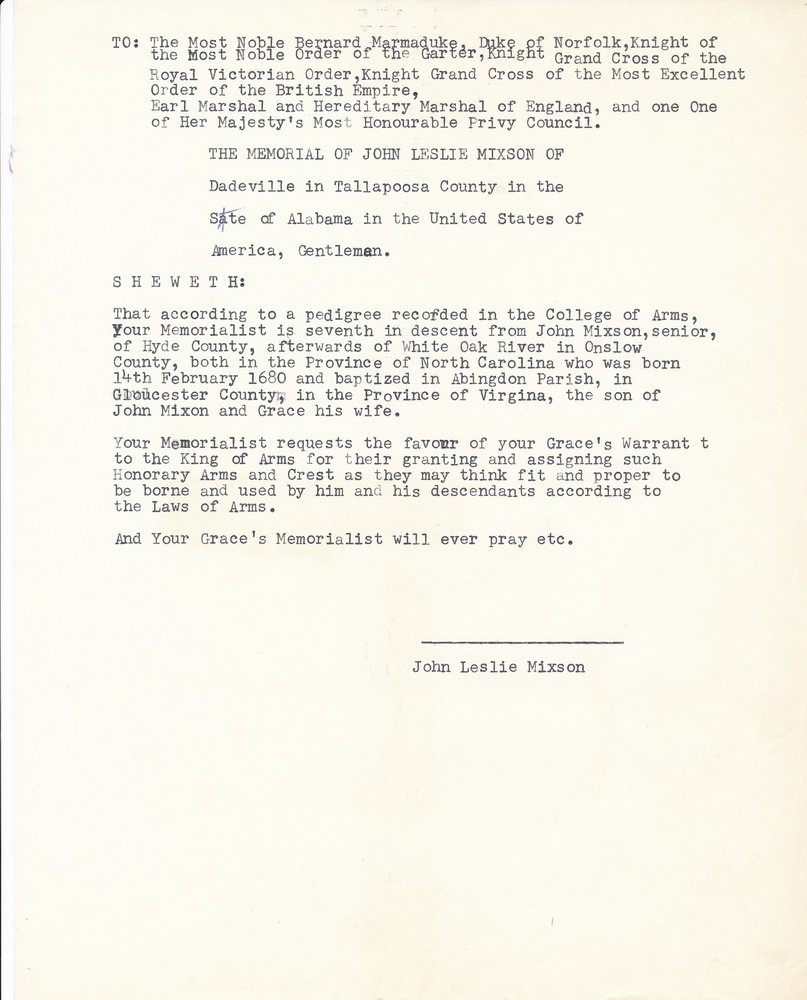
Wow! That is some titles they got there.
In September the Wagner lets John know that the pedigree has been referred to the “official examiners of pedigrees” but lets John know “I am afraid I cannot compel speed on their part but will see what can be done by persuasion.”[f20-c14]
In November the Wagner lets John know that the Official examiners have accepted the pedigree and once the balance of £177.10 has been paid he will be able to send John the form of application.[f20-c15] John writes some figures on back converting it to $426.00. In December the Wagner replies again with some questions about where his brother, sisters and wife and father were born and then replies again in January ’69 about John‘s information was being recorded.[f20-c18]
March 4th of ’69 the Wagner sends John a sketch for the design of “your arms” and requested it back signed and approved. He describes the coat-of-arms,[f20-c19]
"The significance of the design is that the red cross pommée is an emblem of St. Michael, who name can be regarded as the equivalent of the first element in your own name. The Crest this is combined with a sun for the second element in your name, while the shield it is combined with a pattern symbolizing the element ‘mix’.”
The sketch done in crayon.
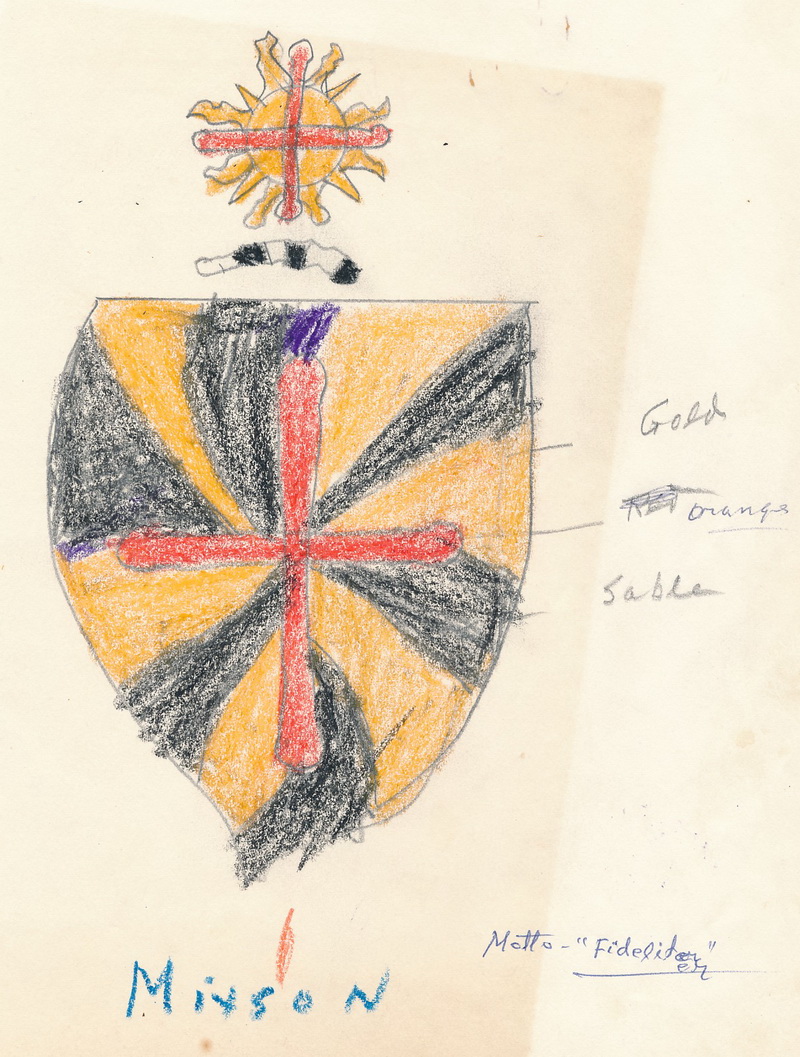
Wagner in the same letter says that he has not suggested a motto and ask John’s views on it. On the draft sketch John wrote “Motto – Fidelitey”.
On March 13th the Wagner thanks John for approving the design and says the motto John proposes “will be perfectly in order.[f20-c20] The asks John about what “designs” (types of copies) he would like for the arms or crest and encloses a leaflet on the subject.[f20-c19]
In September of ’69 the Wagner says the Library Painting of the Arms is ready and provides costs for shipping. John writes on the letter “$24.00 sent 9-29-69”.[f20-c21] John receives the delivery a few weeks later[f20-c23] and lets Wagner know that he would like three more copies .
In December Wagner acknowledges that John wants three more paintings of the arms, one for his daughter and one each for his two grandsons.[f20-c24] Interesting is that he says that “since your daughter is married, she can only display the Mixson arms in conjunction with those of her husband” and the son-in-law is not entitled to arms at the moment. John writes note on letter “$385, letter 12/2/9/69”.
Wagner acknowledges receipt of John’s check and says his son in law’s arms would have to be arms for Burkhead, not Bell and John would have to send him “particulars from his Burkhead ancestry back to an ancestor who was a subject of the British Crown”.[f20-c25]
In January of 1970, Wagner acknowledges receipt of check for $300 and says he understands why John’s son-in-law feels that it would not be worth while taking steps to acquire arms for Burkhead.[f20-c26]
Later in January ’70, Wagner informs John that his account “needs replenishing to the extent of £40” and asks John if he would like an officially certified copy of the pedigree on record.[f20-c27] In a letter in February Wagner acknowledges receipt of the £40 and says an officially certified copy of the pedigree will cost about £100, a book with full leather binding £350, and with cloth binding £275. To have the arms stamped in gold on the cover would be and additional £50.[f20-c28]
In April F. S Andrus “Bluemantle Pursuivant & Assistant to the Greater King of Arms” acknowledges receipt of check for £100 to start work on the pedigree copy. Evidently John asks about extending the Grant of Arms to include other descendants of his grandfather or father and says he will need £31 to look into the matter which is rather complicated.[f20-c29] At the end of April Mr. Andrus says the certified copy of the pedigree is ready and provides shipping costs which was received my Andrus in May who says he send the pedigree by air. [photo pedigree]
In May ’70 Wagner acknowledges receipt of $36 for the shipping of the two additional paintings and advises “leaving this matter too long, as fees have a way of going up”.[d20-c31]
In March of 1971 Wagner acknowledges John’s letter from January 12 but has not been able to answer it until now due to the postal strike (in England).[f20-c32] He says the certified copy of the pedigree will be ready quite soon and will let John know as soon as he gets it from the scrivener. In April Wagner says the pedigree is ready and he will need £2.00 to send by air and in May acknowledges the receipt of the check for $6.00.[f20-c33] This is the last letter from the College of Arms.
It is not clear when John received the certified copy of the pedigree, but it would have been after the last April 1971 letter from John. Enclosed in the folder is an original 12x8 photographic picture negative of the official pedigree. Also included are two copies of the pedigree on paper, one 12x8 and one 16x13, the latter being two pages taped together. The latter one was probably a photocopy of the original one from the COA. The pedigree is signed by Anthony R. Wagner, Garter; J. R. B. Walker, Clarenceux; R. R. Graham-Vivian, Norroy and Ulster. The negative is a color negative but has faded over time and most of the colors faded to shades of gray. Fortunately, I (Larry Mixson) was able to contact Dwight Leslie Mixson, Jr., the grandson of John, in June of 2017 and he had the original pedigree print which he sent me.
Photo of the Original Pedigree from the College of Arms
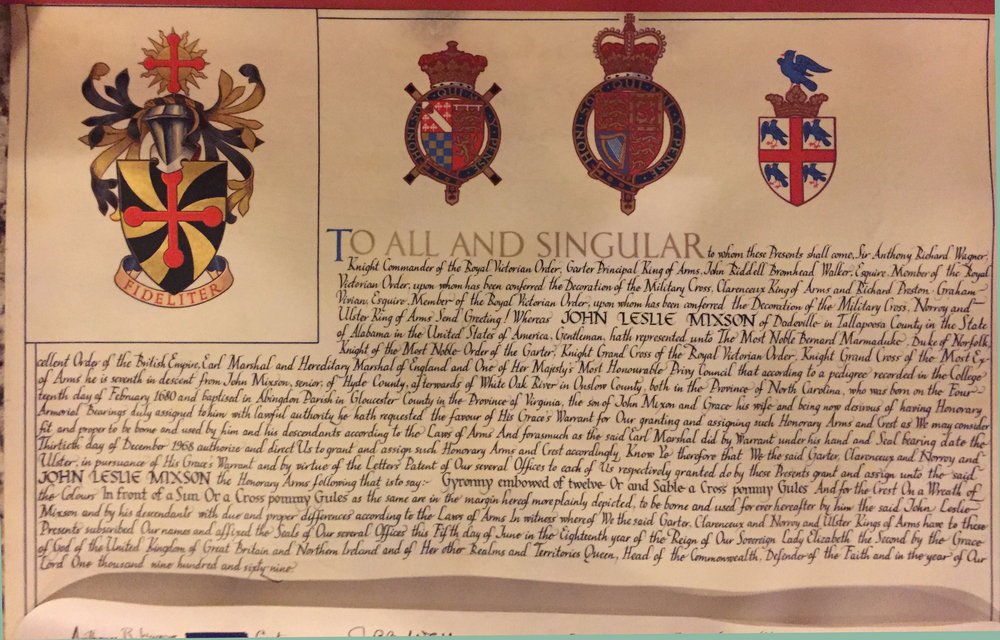
In November ’74, John received the booklet “A Roll of Arms, Eighth Part, 1972”, registered by the Committee on Heraldry of the New England Historic Genealogical Society, Boston which on page 3: Lists Mixson #611 and then on page 14[f20-d05]
611. Mixson, John Leslie, of Dadeville, Alabama
Arms: Gryonny embowered of twelve gold and sable a cross pommy gules.
Crest: In front of a sun gold a cross pommy gules
Motto: FIDELITER
Granted by the College of Arms 1969 The following black and white image in back of the booklet:
The following black and white image in back of the booklet:
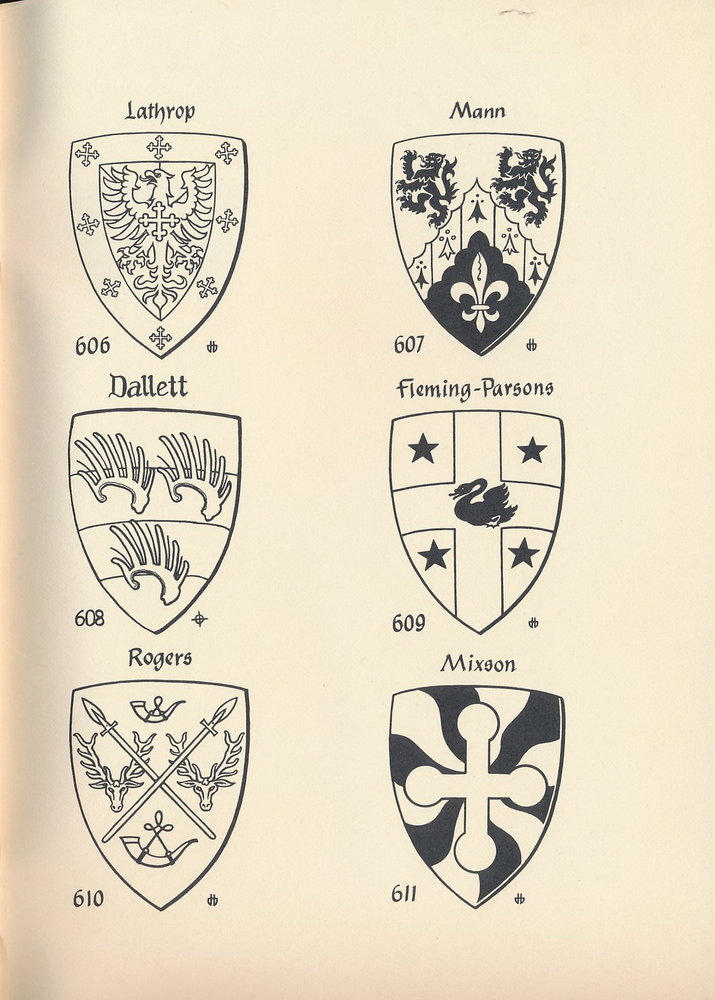
In all it took John Leslie Mixson twelve years and over a thousand dollars to obtain a coat-of-arms from the official College of Arms in London and it was only possible by the detailed genealogy research he had worked on for over twenty years.